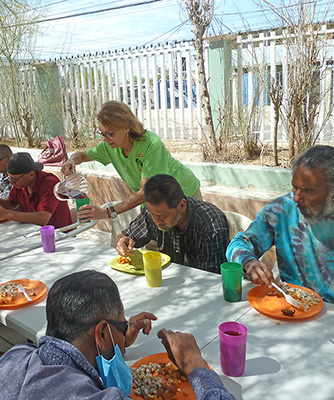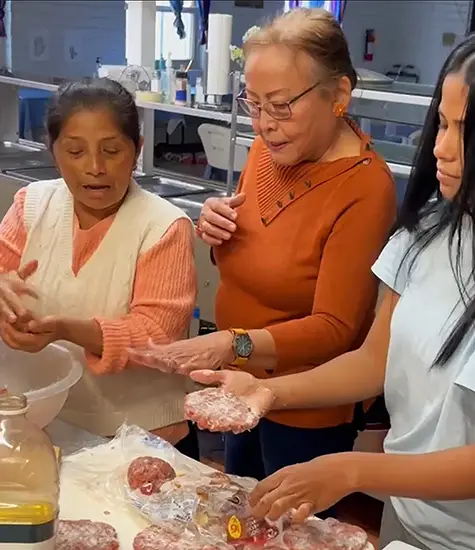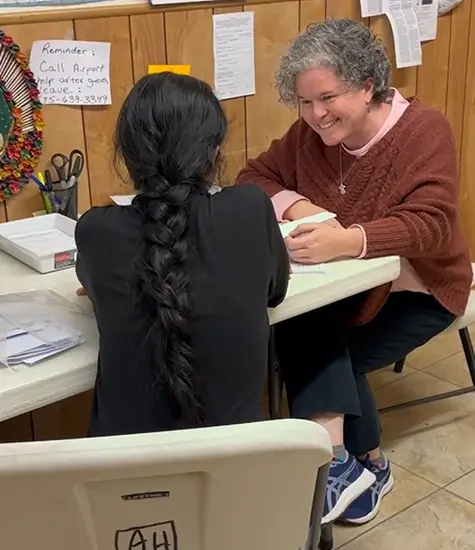Summer 2023 newsletter
Rick Dixon, U.S.-Mexico Border

Diana Byrum serving breakfast at Casa Betania
To better serve the migrant community in Mexicali, Mexico, the local diocese began serving breakfast meals at Casa Betania on April 10.
The afternoon meal, which is served as a take-out meal, continues as always. People pick it up at the front gate between 4 and 5:30 p.m. and eat it where they may, leaning against a wall or sitting on the curb. All are welcome — people experiencing homelessness, migrants and folks who are down and out from the furies of fentanyl or alcohol. Mondays through Fridays, some 400 people are served.
Breakfast is different. It specifically serves the migrant community, including people fresh off La Bestia (“The Beast”), the infamous cargo train on which migrants ride up from southern Mexico; it makes its last stop a half mile from the center. At 10 a.m. we hear the train’s whistle, and by 11 a.m. we have served some eight to 10 people, mostly from Guatemala, Honduras or El Salvador. Most are single young men, although occasionally a family arrives. We welcome them onto the patio area of the center, where they sit at tables under the shade of a palo verde tree flowering with yellow blossoms.

The group of Maryknoll Affiliates and friends in front of a mural of an indigenous girl and factory smoke stacks. From left, our guide, Padre Juan Pineda Onofre; Pam Cibik. Terry Kotalik, Curt and Jan Aberti, Janice Shuler, Linda Thress and Diana Byrum.
The beginning of the new breakfast service coincided with the arrival of a group of seven Maryknoll Affiliates and friends from Ohio and Chicago. Fresh off the jet, they went to work helping prepare and serve breakfast to our guests. What a beauty to watch them relate with the people. Their smiles and willingness to communicate in broken Spanish and in turn the concentration of our guests to listen and share the best they could, flowered with dignity and friendship.
After breakfast the affiliates went to work plastering, sanding and painting Casa Betania. An amazing renovation took place over five days. Before their return, Josefina, the cook; her daughter, Mari; and the entire Pineda Onofre family prepared a barbecue for us at their home. Diana Byrum, Pam Cibik, Linda Thress, Jan Alberti and Janice Shuler presented a line dance, and in turn Josefina and her family taught us a favorite from Mexico, El Ratón Vaquero. Everyone danced, and the beat and joy of their visit still resounds through our hearts.
With freshly painted walls all around, Mari, Josefina and I now welcome our guests in an environment of beauty. We serve breakfast, connect people to legal assistance and listen to lots of stories.
The other day, Edgar, a young man from Nicaragua, limped into Casa Betania and crashed into a chair. His left knee was the size of a football. An hour earlier he had jumped from the top of La Bestia in a panic. The police were approaching, and he jumped off to get away; often migrants are interrogated about criminal affiliations, and in this process some are detained for days.
Also criminal cartels prey on arriving migrants, so if you see someone unfamiliar or “official looking,” you bolt. We explained to Edgar that the U.S. has opened some legal channels for Nicaraguans to enter the U.S. We are thankful for this and put Edgar in contact with the U.N. refugee agency UNHCR (or ACNUR in Spanish).
José, a Guatemalan man, has been trying to apply for political asylum in the United States on the U.S. Customs and Border Protection’s mobile app, known as CBP One. In January of this year, Customs and Border Protection began using the app. Since the end of Title 42 on May 11, the app must be used to apply for asylum. Asylum seekers must apply from a country they are traveling through, such as Mexico, for example.

Terry Kotalik painting the west wall of Casa Betania
José explains that he has been trying for days to get an appointment for asylum on the app. “Nothing goes through,” he says. He places the blame on himself. “I haven’t paid the fee.” No, José, there is no fee to download the app, we inform him. He gives us a blank stare with some relief.
On May 26, the PBS News Hour reported that CBP One only has the capacity to receive 1,000 appointments per day, yet from central and northern Mexico, there are 80,000 people requesting appointments a day. The system is saturated, and the process is slow, even for migrants who are able to get appointments; they will be in Mexico for weeks, perhaps months, waiting for their hearings. With shelters full, many migrants live in encampments with appalling sanitary conditions.
Another challenge exists for people who have had their phones stolen on the trek north. The requirement to use the app is a great obstacle for many migrants, especially for the poorest ones.
And there are other regulations. If you enter the U.S. illegally and are caught, you are banned for five years from applying for asylum. If you try again and are caught, it’s jail time.
Felix, from El Salvador, arrived for breakfast on June 7. He thanked us for the meal, saying it was the best breakfast he had ever had. He had just been released from a U.S. detention center and deported to Mexico. He’s from El Salvador, so why deport him to Mexico? I wondered.
José gave up, at least for now, on applying for asylum in the U.S. and went to the Instituto Nacional de Migración (Mexico’s immigration agency) and got a visitor’s visa to work in Mexico. In Mexicali, there is a dire shortage of workers in the maquiladoras, factories from the U.S., Japan and Europe that make everything from tractor trailers to microchips. Last week José applied for a job in one; he smiled when he told me it looked promising. Promising for whom? I wondered.
These factories are infamous for low wages and long hours, but you don’t hear workers complaining. The alternative is working in the informal economy, selling whatever you can on the streets or unloading tractor trailers in three-digit temperatures at La Yarda (where everything imaginable in fruit, vegetables and spices is warehoused and sold).
José’s story and the confusion around these regulations elicit a few more questions. Is the United States trying to prevent people from applying for asylum even though the U.S. constitution guarantees this right? Is the aim of these regulations, at least in part, to persuade migrants to remain in Mexico? Why is the U.S. so afraid of comprehensive immigration reform?
In ruminating all this, I often think of the affiliates’ group. They modeled how to live these questions as a Gospel endeavor. Their lives, actions and friendship made it clear that no matter how controversial the issues are, nothing takes the place of being close to our most vulnerable brothers and sisters. Proximity and friendship say so much about how the work of God is a humble service, and in the midst of it, we are never alone. Thank you, Maryknoll Affiliates.
Please consider joining our circle of COMPANIONS IN MISSION. Companions in Mission are generous donors, like you, who give financial gifts on a regular (usually monthly) basis. For more information visit Become a Companion in Mission. Thank you so much for your generosity!











Thank you so much Rick for sharing with us all of your experience, your thoughts/perspective and your hope and inspiration! Your presence is a blessing for all whom you encounter.